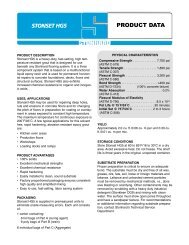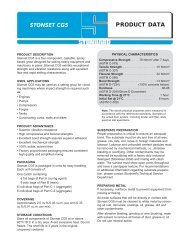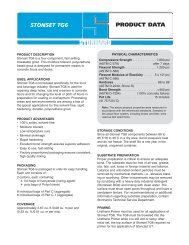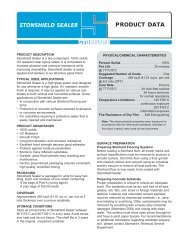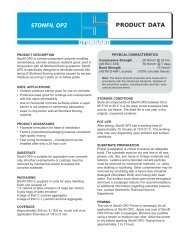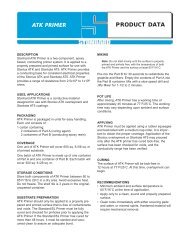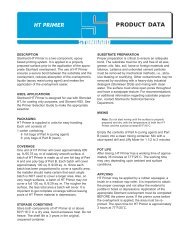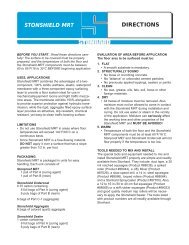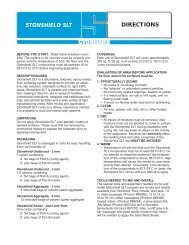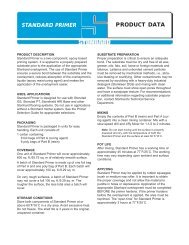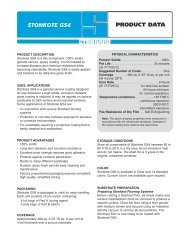Stonseal AC6.pdf - StonCor Europe
Stonseal AC6.pdf - StonCor Europe
Stonseal AC6.pdf - StonCor Europe
Create successful ePaper yourself
Turn your PDF publications into a flip-book with our unique Google optimized e-Paper software.
STONSEAL AC6<br />
PRODUCT DATA<br />
PRODUCT DESCRIPTION<br />
<strong>Stonseal</strong> AC6 is a two-component, UV resistant, clear,<br />
aliphatic, polyaspartic urethane sealer. It is formulated<br />
to increase abrasion and chemical resistance while<br />
improving cleanability. <strong>Stonseal</strong> AC6 is easily applied<br />
and hardens to an attractive reduced gloss finish.<br />
USES, APPLICATIONS<br />
<strong>Stonseal</strong> AC6 is a reduced gloss sealer designed for<br />
use whenever a reduced gloss, UV resistant finish is<br />
required. It may be applied on various substrates to<br />
both vertical and horizontal surfaces. Some applications<br />
of <strong>Stonseal</strong> AC6 are:<br />
• In conjunction with various Stonhard flooring<br />
systems<br />
• For substrates requiring a protective sealer that is<br />
easily cleaned and maintained<br />
PRODUCT ADVANTAGES<br />
• UV resistant<br />
• Long-term abrasion and corrosion resistance<br />
• Excellent bond strength assures good adhesion<br />
• Protects against moisture penetration<br />
• Durable, reduced gloss finish permits easy cleaning<br />
and maintenance<br />
• Factory proportioned packaging ensures consistent,<br />
high quality, simplified mixing<br />
PHYSICAL CHARACTERISTICS<br />
Percent Solids . . . . . . . . . . . . . . . . . . . . . . . . 95%<br />
V.O.C. . . . . . . . . . . . . . . . . . . . . . . . . . . . . . . . 77 g/l<br />
Pot Life . . . . . . . . . . . . . . . . . . . . . . . . . 20 minutes<br />
(@ 77˚F/25˚C)<br />
Suggested Number of Coats . . . . . . . . . . . . . One<br />
Coverage. . . . . . . . . 750 sq. ft./69.7 sq. m per unit<br />
Cure Rate . . . . . . . . . . . . . . . . . . . . . . . . . . 6 hours<br />
(@ 77˚F/25˚C)<br />
for tack-free surface<br />
24 hours minimum<br />
for normal operations<br />
Heat Resistance Limitations . . . . . . . 200˚F/93˚C<br />
continuous exposure<br />
250˚F/121˚C<br />
intermittent exposure<br />
Fire Resistance of Dry Film . . . Self-extinguishing<br />
Note: The above physical properties were measured in<br />
accordance with the referenced standards. Samples of<br />
the actual floor system, including binder and filler, were<br />
used as test specimens.<br />
STORAGE CONDITIONS<br />
Store all components of <strong>Stonseal</strong> AC6 between 60 to<br />
85˚F/16 to 29˚C in a dry area. Avoid excessive heat<br />
and do not freeze. The shelf life is one year in the<br />
original, unopened container.<br />
PACKAGING<br />
<strong>Stonseal</strong> AC6 is packaged in units for easy handling.<br />
Each unit consists of one carton containing:<br />
1 foil bag of isocyanate (curing agent)<br />
(1) 1 gallon can of polyol (resin)<br />
1 poly bag of Part C<br />
SURFACE PREPARATION<br />
Before coating a Stonhard floor, surface imperfections<br />
must be removed to produce a uniform surface.<br />
Thoroughly vacuum the floor to remove all loose<br />
aggregate and debris. The Stonhard floor is now<br />
ready to be coated with <strong>Stonseal</strong> AC6 Sealer.<br />
COVERAGE<br />
Approximately 750 sq. ft./69.7 sq. m per unit over<br />
most substrates.<br />
Preparing Concrete Substrates<br />
Proper preparation is critical to ensure an adequate<br />
bond. The substrate must be dry and free of all wax,<br />
grease, oils, fats, soil, loose or foreign materials and<br />
laitance. Laitance and unbonded cement particles<br />
must be removed by mechanical methods, i.e., abrasive<br />
blasting or scarifying. Other contaminants may be<br />
removed by scrubbing with a heavy-duty industrial
detergent (Stonkleen DG9) and rinsing with clean<br />
water. The surface must show open pores throughout<br />
and have a sandpaper texture. For recommendations<br />
or additional information regarding substrate preparation,<br />
contact Stonhard's Technical Service<br />
Department.<br />
PRIMING<br />
For use over a Stonhard floor, no primer is necessary.<br />
For use over a concrete substrate, Stoncrest GS3 or<br />
HT Primer are recommended to ensure maximum<br />
product performance.<br />
MIXING<br />
<strong>Stonseal</strong> AC6 is supplied in factory proportioned<br />
quantities. To achieve thorough and proper mixing,<br />
the <strong>Stonseal</strong> AC6 must be mixed using a heavy-duty,<br />
slow-speed drill (400 to 600 rpm) with a Jiffy Mixer<br />
(Product #87028). Empty the contents of the polyol<br />
resin and Part C into a clean mixing container. Mix the<br />
two components for 30 seconds or until the material<br />
has a uniform appearance. Add the isocyanate and<br />
continue to mix the material to a uniform consistency<br />
for 1 to 2 minutes. Avoid high speed mixing that will<br />
entrain air into the mix. Thorough mixing of the three<br />
components is required.<br />
POT LIFE<br />
After mixing, <strong>Stonseal</strong> AC6 has a working time of<br />
approximately 20 minutes at 70˚F/21˚C. The working<br />
time may vary depending upon ambient and surface<br />
conditions. At high humidity levels working time will be<br />
substantially decreased.<br />
APPLYING<br />
<strong>Stonseal</strong> AC6 can be applied at ambient temperatures<br />
of 60 to 85˚F/16 to 29˚C and humidity below 80%.<br />
The Sealer must be applied immediately after mixing<br />
the two components. <strong>Stonseal</strong> AC6 is applied with a<br />
rubber squeegee and medium nap roller. The roller is<br />
used to remove squeegee lines and smooth out the<br />
surface. A brush may be used where necessary. Each<br />
additional coat may be applied when the surface is<br />
tack-free (about 6 hours). Any questions regarding the<br />
application of <strong>Stonseal</strong> AC6 should be directed to<br />
Stonhard's Technical Service Department.<br />
CURING<br />
The surface of <strong>Stonseal</strong> AC6 will be tack-free in 6<br />
hours at 77˚F/25˚C. The coated area may be put back<br />
into service in 24 hours. Ultimate physical characteristics<br />
will be achieved in 7 days.<br />
RECOMMENDATIONS<br />
• Apply only on a clean, sound and properly prepared<br />
substrate.<br />
• Minimum ambient and surface temperatures are<br />
60˚F/16˚C at the time of application.<br />
• Do not use water or steam in the vicinity of the<br />
application. Moisture can seriously affect the<br />
working time and properties of the material.<br />
• Application and curing times are dependent upon<br />
ambient and surface conditions.<br />
PRECAUTIONS<br />
• Acetone is recommended for clean up of the unreacted<br />
<strong>Stonseal</strong> AC6 material. Use these materials<br />
only in strict accordance with the manufacturer's<br />
recommended safety procedures. Dispose of waste<br />
materials in accordance with government regulations.<br />
The reacted material will require mechanical<br />
means of removal.<br />
• The use of NIOSH/MSHA approved respirators,<br />
safety goggles and impervious gloves is<br />
recommended.<br />
• In case of contact, flush the area for 15 minutes<br />
with copious amounts of water and seek medical<br />
attention. Wash skin with soap and water.<br />
• Use only with adequate ventilation.<br />
NOTES<br />
• For environments not referenced in the Chemical<br />
Resistance Guide, consult Stonhard’s Technical<br />
Service Department for recommendations.<br />
• Material Safety Data Sheets for <strong>Stonseal</strong> AC6 are<br />
available upon request.<br />
• A staff of technical service engineers is available to<br />
assist with product application or to answer questions<br />
related to Stonhard’s products.<br />
• Requests for technical literature or service can be<br />
made through local sales representatives or corporate<br />
offices located worldwide.
CHEMICAL RESISTANCE GUIDE<br />
The purpose of this guide is to aid in determining the<br />
potential value of <strong>Stonseal</strong> AC6 when exposed to the<br />
damaging effects of corrosive chemical environments.<br />
RATING CODE<br />
E - Excellent<br />
G - Good<br />
NR - Not Recommended<br />
OS - Suitable for use where “occasional spillages”<br />
occur, when flushing with water immediately<br />
follows.<br />
RATING<br />
Acetic – 5% . . . . . . . . . . . . . . . . . . . . . . . . . . . . . . . E<br />
Acetic – 10% . . . . . . . . . . . . . . . . . . . . . . . . . . . . . . E<br />
Acetic – 15% . . . . . . . . . . . . . . . . . . . . . . . . . . . . . . E<br />
Acetic – 20% . . . . . . . . . . . . . . . . . . . . . . . . . . . . . . E<br />
Acetic – 50% . . . . . . . . . . . . . . . . . . . . . . . . . . . . . . G<br />
Acetic Glacial . . . . . . . . . . . . . . . . . . . . . . . . . . . . OS<br />
Benzoic – Sat. 3% . . . . . . . . . . . . . . . . . . . . . . . . . E<br />
Boric – Sat. 30% . . . . . . . . . . . . . . . . . . . . . . . . . . . E<br />
Butyric – 10%. . . . . . . . . . . . . . . . . . . . . . . . . . . . . . E<br />
Chromic – 10% . . . . . . . . . . . . . . . . . . . . . . . . . . . . G<br />
Chromic – 15% . . . . . . . . . . . . . . . . . . . . . . . . . . . OS<br />
Chromic – 40% . . . . . . . . . . . . . . . . . . . . . . . . . . . NR<br />
Citric – 50% . . . . . . . . . . . . . . . . . . . . . . . . . . . . . . . E<br />
Cresylic . . . . . . . . . . . . . . . . . . . . . . . . . . . . . . . . . . G<br />
Diglycolic . . . . . . . . . . . . . . . . . . . . . . . . . . . . . . . . . G<br />
Fatty . . . . . . . . . . . . . . . . . . . . . . . . . . . . . . . . . . . . . E<br />
Fluoboric . . . . . . . . . . . . . . . . . . . . . . . . . . . . . . . OS<br />
Formic – up to 10% . . . . . . . . . . . . . . . . . . . . . . . . G<br />
Formic – over 10% . . . . . . . . . . . . . . . . . . . . . . . . OS<br />
Heptanoic . . . . . . . . . . . . . . . . . . . . . . . . . . . . . . . . G<br />
Hydrochloric – 15% . . . . . . . . . . . . . . . . . . . . . . . . . E<br />
Hydrochloric – 37% . . . . . . . . . . . . . . . . . . . . . . . . . G<br />
Hydrofluoric – 5% . . . . . . . . . . . . . . . . . . . . . . . . . . G<br />
Hydrofluoric – 10% . . . . . . . . . . . . . . . . . . . . . . . . OS<br />
Hydrofluoric – 15% . . . . . . . . . . . . . . . . . . . . . . . . NR<br />
Hypochlorous – 5% . . . . . . . . . . . . . . . . . . . . . . . . . E<br />
Lactic – up to 20% . . . . . . . . . . . . . . . . . . . . . . . . . . E<br />
ACIDS<br />
RATING<br />
Lactic – over 20% . . . . . . . . . . . . . . . . . . . . . . . . . . G<br />
Maleic – up to 10% . . . . . . . . . . . . . . . . . . . . . . . . . E<br />
Maleic – 40% . . . . . . . . . . . . . . . . . . . . . . . . . . . . . . E<br />
Maleic – Sat. . . . . . . . . . . . . . . . . . . . . . . . . . . . . . . G<br />
Monochloroacetic – 5% . . . . . . . . . . . . . . . . . . . . . . G<br />
Monochloroacetic – 10% . . . . . . . . . . . . . . . . . . . . . G<br />
Monochloroacetic – 20%. . . . . . . . . . . . . . . . . . . . OS<br />
Nitric – 10% . . . . . . . . . . . . . . . . . . . . . . . . . . . . . . . E<br />
Nitric – 20% . . . . . . . . . . . . . . . . . . . . . . . . . . . . . . . E<br />
Nitric – 30% . . . . . . . . . . . . . . . . . . . . . . . . . . . . . . . G<br />
Nitric – over 40%. . . . . . . . . . . . . . . . . . . . . . . . . . NR<br />
Oleic . . . . . . . . . . . . . . . . . . . . . . . . . . . . . . . . . . . . E<br />
Oxalic – Sat. . . . . . . . . . . . . . . . . . . . . . . . . . . . . . . E<br />
Perchloric – 35%. . . . . . . . . . . . . . . . . . . . . . . . . . OS<br />
Phosphoric – up to 70% . . . . . . . . . . . . . . . . . . . . . E<br />
Phosphoric – Conc. 85% . . . . . . . . . . . . . . . . . . . OS<br />
Picric – Sat. . . . . . . . . . . . . . . . . . . . . . . . . . . . . . . . E<br />
Phthalic . . . . . . . . . . . . . . . . . . . . . . . . . . . . . . . . . . G<br />
Succinic – Sat. . . . . . . . . . . . . . . . . . . . . . . . . . . . . . E<br />
Sulfuric – 20% . . . . . . . . . . . . . . . . . . . . . . . . . . . . . E<br />
Sulfuric – 50% . . . . . . . . . . . . . . . . . . . . . . . . . . . . . G<br />
Sulfuric – 70%. . . . . . . . . . . . . . . . . . . . . . . . . . . . NR<br />
Sulfuric – 98%. . . . . . . . . . . . . . . . . . . . . . . . . . . . NR<br />
Tannic – Sat. . . . . . . . . . . . . . . . . . . . . . . . . . . . . . . E<br />
Tartanic – Sat. . . . . . . . . . . . . . . . . . . . . . . . . . . . . . E<br />
Trichloroacetic 10% . . . . . . . . . . . . . . . . . . . . . . . . . G<br />
Trichloroacetic 20%. . . . . . . . . . . . . . . . . . . . . . . . OS<br />
ALKALIES AND SALTS<br />
RATING<br />
Aluminum Chloride – 50% . . . . . . . . . . . . . . . . . . . . E<br />
Ammonium Chloride – 50% . . . . . . . . . . . . . . . . . . . E<br />
Ammonium Hydroxide – up to 20% . . . . . . . . . . . . . E<br />
Ammonium Hydroxide – 40% . . . . . . . . . . . . . . . . . E<br />
Ammonium Nitrate – Sat.. . . . . . . . . . . . . . . . . . . . . E<br />
Ammonium Sulfate – Sat. . . . . . . . . . . . . . . . . . . . . E<br />
Calcium Chloride – Sat. . . . . . . . . . . . . . . . . . . . . . . E<br />
Calcium Hydroxide – Sat. . . . . . . . . . . . . . . . . . . . . E<br />
Calcium Hypochlorite – up to 15%. . . . . . . . . . . . . . E<br />
Copper Fluoroborate . . . . . . . . . . . . . . . . . . . . . . . . E<br />
Ferric Chloride – Sat. . . . . . . . . . . . . . . . . . . . . . . . . E<br />
Ferrous Sulfate. . . . . . . . . . . . . . . . . . . . . . . . . . . . . E<br />
Potassium Hydroxide – up to 40%. . . . . . . . . . . . . . E<br />
Sodium Benzoate. . . . . . . . . . . . . . . . . . . . . . . . . . . E<br />
RATING<br />
Sodium Carbonate (Soda Ash) – Sat. . . . . . . . . . . E<br />
Sodium Bicarbonate – Sat. . . . . . . . . . . . . . . . . . . . E<br />
Sodium Bisulfate – Sat. . . . . . . . . . . . . . . . . . . . . . . E<br />
Sodium Bisulfite – Sat.. . . . . . . . . . . . . . . . . . . . . . . E<br />
Sodium Chloride (Salt) – Sat. . . . . . . . . . . . . . . . . . E<br />
Sodium Glutamate . . . . . . . . . . . . . . . . . . . . . . . . . E<br />
Sodium Hydroxide – up to 50% . . . . . . . . . . . . . . . . E<br />
Sodium Hypochlorite – up to 10% . . . . . . . . . . . . . . G<br />
Sodium Sulfate – Sat. . . . . . . . . . . . . . . . . . . . . . . . E<br />
Sodium Sulfite – Sat. . . . . . . . . . . . . . . . . . . . . . . . E<br />
Sodium Sulfide – Sat. . . . . . . . . . . . . . . . . . . . . . . . E<br />
Trisodium Phosphate – Sat.. . . . . . . . . . . . . . . . . . . E<br />
Zinc Nitrate . . . . . . . . . . . . . . . . . . . . . . . . . . . . . . . E
SOLVENTS AND OTHER CHEMICALS<br />
RATING<br />
Acetone . . . . . . . . . . . . . . . . . . . . . . . . . . . . . . . OS<br />
Acrylonitrile. . . . . . . . . . . . . . . . . . . . . . . . . . . . . OS<br />
Aniline. . . . . . . . . . . . . . . . . . . . . . . . . . . . . . . . . NR<br />
Alcohol (Methyl) . . . . . . . . . . . . . . . . . . . . . . . . . OS<br />
Alcohol (Ethyl, Propyl, Isopropyl, Butyl) . . . . . . . . G<br />
Amyl Acetate . . . . . . . . . . . . . . . . . . . . . . . . . . . . . E<br />
Beer. . . . . . . . . . . . . . . . . . . . . . . . . . . . . . . . . . . . E<br />
Benzene . . . . . . . . . . . . . . . . . . . . . . . . . . . . . . . . G<br />
Bromine . . . . . . . . . . . . . . . . . . . . . . . . . . . . . . . NR<br />
Butyl Acetate. . . . . . . . . . . . . . . . . . . . . . . . . . . . . G<br />
Butyl Lactate. . . . . . . . . . . . . . . . . . . . . . . . . . . . . G<br />
Carbon Disulfide. . . . . . . . . . . . . . . . . . . . . . . . . NR<br />
Carbon Tetrachloride. . . . . . . . . . . . . . . . . . . . . . . E<br />
Chlorobenzene . . . . . . . . . . . . . . . . . . . . . . . . . . . E<br />
Corn Oil. . . . . . . . . . . . . . . . . . . . . . . . . . . . . . . . . E<br />
Cyclohexane . . . . . . . . . . . . . . . . . . . . . . . . . . . . . E<br />
Cyclohexanol. . . . . . . . . . . . . . . . . . . . . . . . . . . . . E<br />
Cyclohexanone. . . . . . . . . . . . . . . . . . . . . . . . . . . G<br />
Chloroform . . . . . . . . . . . . . . . . . . . . . . . . . . . . . NR<br />
Diacetone Alcohol . . . . . . . . . . . . . . . . . . . . . . . . . E<br />
Diethyl Phthalate. . . . . . . . . . . . . . . . . . . . . . . . . . E<br />
Dimethyl Phthalate . . . . . . . . . . . . . . . . . . . . . . . . E<br />
Ethyl Acetate. . . . . . . . . . . . . . . . . . . . . . . . . . . . . G<br />
Ethylene Glycol . . . . . . . . . . . . . . . . . . . . . . . . . . . E<br />
Ether . . . . . . . . . . . . . . . . . . . . . . . . . . . . . . . . . . . G<br />
Ethylene Dichloride . . . . . . . . . . . . . . . . . . . . . . OS<br />
Formaldehyde . . . . . . . . . . . . . . . . . . . . . . . . . . . . E<br />
Gasoline . . . . . . . . . . . . . . . . . . . . . . . . . . . . . . . . E<br />
Glycerine. . . . . . . . . . . . . . . . . . . . . . . . . . . . . . . . E<br />
Gyoxal. . . . . . . . . . . . . . . . . . . . . . . . . . . . . . . . . . E<br />
Hydrogen Peroxide – 10% . . . . . . . . . . . . . . . . . . E<br />
JP5 Jet Fuel . . . . . . . . . . . . . . . . . . . . . . . . . . . . . E<br />
Juices – Fruit. . . . . . . . . . . . . . . . . . . . . . . . . . . . . E<br />
Juices – Vegetable . . . . . . . . . . . . . . . . . . . . . . . . E<br />
RATING<br />
Kerosene. . . . . . . . . . . . . . . . . . . . . . . . . . . . . . . . E<br />
Lanoline. . . . . . . . . . . . . . . . . . . . . . . . . . . . . . . . . E<br />
Lard. . . . . . . . . . . . . . . . . . . . . . . . . . . . . . . . . . . . E<br />
Linseed Oil . . . . . . . . . . . . . . . . . . . . . . . . . . . . . . E<br />
Mayonnaise. . . . . . . . . . . . . . . . . . . . . . . . . . . . . . E<br />
Methyl Ethyl Ketone . . . . . . . . . . . . . . . . . . . . . . OS<br />
Methyl Isobutyl Ketone . . . . . . . . . . . . . . . . . . . . . G<br />
Methyl Salicylate – 50% in Toluene . . . . . . . . . . . G<br />
Methylene Chloride . . . . . . . . . . . . . . . . . . . . . . NR<br />
Milk . . . . . . . . . . . . . . . . . . . . . . . . . . . . . . . . . . . . E<br />
Mineral Spirits . . . . . . . . . . . . . . . . . . . . . . . . . . . . E<br />
Muriatic Acid (See Hydrochloric Acid) . . . . . . . . NR<br />
Mustard . . . . . . . . . . . . . . . . . . . . . . . . . . . . . . . . . E<br />
Naphtha. . . . . . . . . . . . . . . . . . . . . . . . . . . . . . . . . E<br />
Naphthalene . . . . . . . . . . . . . . . . . . . . . . . . . . . . . E<br />
Oils – Cutting . . . . . . . . . . . . . . . . . . . . . . . . . . . . E<br />
Oils – Mineral . . . . . . . . . . . . . . . . . . . . . . . . . . . . E<br />
Oils – Vegetable . . . . . . . . . . . . . . . . . . . . . . . . . . E<br />
Peanut Butter . . . . . . . . . . . . . . . . . . . . . . . . . . . . E<br />
Perchloroethylene . . . . . . . . . . . . . . . . . . . . . . . . . E<br />
Phenol – 5%. . . . . . . . . . . . . . . . . . . . . . . . . . . . OS<br />
Pyridine . . . . . . . . . . . . . . . . . . . . . . . . . . . . . . . OS<br />
Skydrol . . . . . . . . . . . . . . . . . . . . . . . . . . . . . . . . . E<br />
Sucrose – Sat. (Sugar) . . . . . . . . . . . . . . . . . . . . . E<br />
Toluene . . . . . . . . . . . . . . . . . . . . . . . . . . . . . . . . . E<br />
Triacetin . . . . . . . . . . . . . . . . . . . . . . . . . . . . . . . . E<br />
Trichloroethane. . . . . . . . . . . . . . . . . . . . . . . . . . . G<br />
Trichloroethylene . . . . . . . . . . . . . . . . . . . . . . . . OS<br />
Triethanolamine . . . . . . . . . . . . . . . . . . . . . . . . . OS<br />
Triethylene Glycol . . . . . . . . . . . . . . . . . . . . . . . . . E<br />
Urea . . . . . . . . . . . . . . . . . . . . . . . . . . . . . . . . . . . E<br />
Vinegar (Household) . . . . . . . . . . . . . . . . . . . . . . . E<br />
Water. . . . . . . . . . . . . . . . . . . . . . . . . . . . . . . . . . . E<br />
Wine . . . . . . . . . . . . . . . . . . . . . . . . . . . . . . . . . . . E<br />
Xylene . . . . . . . . . . . . . . . . . . . . . . . . . . . . . . . . . . E<br />
Note: This data is based on laboratory tests performed under carefully controlled conditions. (All solutions are at ambient<br />
temperatures.) No warranty can be expressed nor implied regarding the accuracy of this information as it will apply to actual<br />
plant operation or job site use. Plant operations and job site uses vary widely, and the individual results obtained are affected<br />
by the specific conditions encountered, which are beyond our control.<br />
IMPORTANT:<br />
Stonhard believes the information contained here to be true and accurate as of the date of publication. Stonhard makes no warranty, expressed or implied, based on this literature and<br />
assumes no responsibility for consequential or incidental damages in the use of the systems described, including any warranty of merchantability or fitness. Information contained here is<br />
for evaluation only. We further reserve the right to modify and change products or literature at any time and without prior notice.<br />
2/07<br />
Rev. 2/07<br />
A Division of<br />
, Inc.<br />
www.stonhard.com<br />
Worldwide Offices:<br />
USA<br />
Canada<br />
800-257-7953<br />
905-430-3333<br />
Mexico<br />
South America<br />
(52)-55-9140-4500<br />
(54-3327)-44-2222<br />
<strong>Europe</strong><br />
Middle East<br />
(32)-2-720-8982<br />
(971)-4-3470460<br />
Africa<br />
Asia<br />
(27)-11-254-5500<br />
(86)-21-5466-5118




